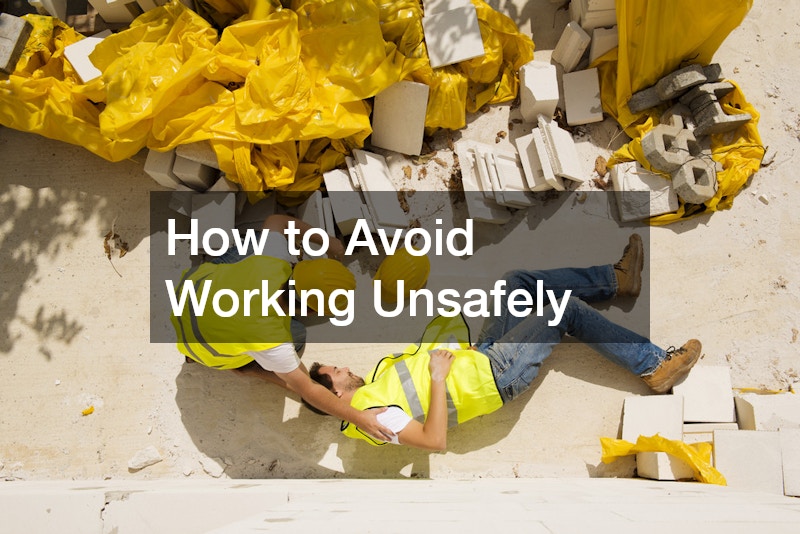Working unsafely can lead to serious injuries, financial loss, and even fatalities. It is crucial for businesses of all sizes and industries to prioritize safety in the workplace. By adhering to established safety guidelines and fostering a culture of safety, companies can protect their employees, enhance productivity, and reduce the risk of accidents. This blog will provide insights and strategies to help businesses avoid working unsafely, ensuring a safer work environment for everyone involved.
Understanding the importance of safety and implementing effective safety measures is not just about compliance; it’s about caring for the well-being of employees and creating a sustainable, productive work environment. By focusing on key areas such as safety guidelines, personal protective equipment, and hazard identification, businesses can significantly reduce the risks associated with working unsafely. Let’s explore these aspects in more detail.
Understanding Workplace Safety Guidelines
Understanding workplace safety guidelines is the foundation for preventing accidents and injuries. These guidelines provide a framework for identifying hazards, implementing safety measures, and ensuring that employees are aware of their responsibilities. Adhering to these guidelines helps create a safe and healthy work environment, reducing the likelihood of accidents and promoting overall well-being.
For a local wedding venue, understanding and following workplace safety guidelines is essential to ensure the safety of staff and guests. This includes guidelines for fire safety, food handling, and emergency procedures. By training employees on these safety protocols and conducting regular safety drills, the wedding venue can prevent accidents and ensure that all events run smoothly without any safety incidents. Adhering to safety guidelines not only protects staff and guests but also enhances the venue’s reputation as a safe and reliable location for events.
Using Personal Protective Equipment

Using personal protective equipment (PPE) is a critical measure to prevent injuries and ensure safety in the workplace. PPE includes items such as helmets, gloves, masks, and safety glasses that protect employees from potential hazards. Employers must provide appropriate PPE and ensure that employees are trained on its proper use and maintenance. Consistent use of PPE significantly reduces the risk of injuries and illnesses caused by working unsafely.
For a software developer, using personal protective equipment might seem less obvious compared to more physically demanding jobs, but it is still important. For example, ergonomic equipment such as wrist supports, adjustable chairs, and screen protectors can prevent repetitive strain injuries and eye strain. Ensuring that software developers have access to and use these ergonomic aids can enhance their comfort and productivity, reducing the risk of long-term health issues associated with working unsafely in an office environment.
Identifying Potential Hazards
Identifying potential hazards in the workplace is a proactive approach to preventing accidents and ensuring safety. This involves regularly inspecting the work environment, evaluating processes, and identifying any conditions or practices that could lead to injury or illness. By recognizing these hazards early, businesses can implement corrective measures to mitigate risks and prevent incidents caused by working unsafely.
For a chiropractor, identifying potential hazards is crucial to maintaining a safe practice. This includes ensuring that equipment such as adjustment tables and therapeutic devices are in good working condition, the workspace is free of obstacles that could cause trips or falls, and proper lifting techniques are used when handling patients. Regularly reviewing safety protocols and making necessary adjustments helps create a safe environment for both staff and patients, reducing the risk of injuries and improving overall care.
Implementing Safety Training Programs

Implementing safety training programs is essential for educating employees about workplace hazards and proper safety practices. These programs should cover a range of topics, including emergency procedures, equipment operation, and the correct use of personal protective equipment. Ongoing training ensures that all employees are up-to-date on the latest safety protocols and understand their role in maintaining a safe work environment.
For a moving company, implementing safety training programs is particularly important due to the physical nature of the work. Training employees on proper lifting techniques, the safe handling of heavy objects, and the use of moving equipment like dollies and straps can prevent injuries and accidents. Additionally, teaching drivers about safe driving practices and vehicle maintenance can reduce the risk of traffic accidents. Comprehensive safety training helps ensure that all employees are equipped to perform their tasks safely, minimizing the likelihood of working unsafely.
Maintaining Clean and Organized Workspaces
Maintaining clean and organized workspaces is a simple yet effective way to enhance workplace safety. A clutter-free environment reduces the risk of trips, falls, and other accidents. Regular cleaning and organization also help ensure that safety equipment is easily accessible and that hazards are promptly addressed. A well-maintained workspace promotes efficiency and reduces the potential for accidents caused by working unsafely.
For a local screen printing company, maintaining clean and organized workspaces is essential to prevent accidents and ensure smooth operations. This includes keeping printing equipment and supplies neatly arranged, ensuring that pathways are clear of obstructions, and promptly cleaning up any spills or debris. Regularly inspecting the workspace for potential hazards and addressing them immediately can prevent injuries and equipment damage. By prioritizing cleanliness and organization, the screen printing company can create a safer, more productive work environment for its employees.
Encouraging Open Communication
Encouraging open communication is vital for maintaining a safe workplace. When employees feel comfortable reporting hazards and safety concerns, businesses can address issues promptly and prevent accidents. Establishing clear channels for communication and fostering a culture where safety is a shared responsibility helps ensure that everyone is vigilant about potential risks and committed to working safely.
For an excavating company, encouraging open communication can significantly enhance workplace safety. Workers on excavation sites face numerous hazards, such as unstable soil, heavy machinery, and underground utilities. By promoting a culture where employees can freely report unsafe conditions or suggest safety improvements without fear of retribution, the company can quickly address potential dangers. Regular safety meetings and anonymous reporting options can further facilitate open communication, helping to prevent accidents and injuries caused by working unsafely.
Conducting Regular Safety Inspections

Conducting regular safety inspections is an essential practice for identifying and mitigating workplace hazards. Inspections should be systematic and thorough, covering all aspects of the work environment, equipment, and procedures. By regularly evaluating the workplace for safety compliance, businesses can ensure that safety standards are maintained and that any issues are promptly addressed, reducing the risk of accidents and injuries.
For a mold remediation service, conducting regular safety inspections is crucial to ensure the health and safety of employees and clients. Inspectors should check for proper use of protective equipment, ensure that containment areas are secure, and verify that ventilation systems are functioning correctly to prevent mold spores from spreading. Additionally, inspections should include reviewing the handling and disposal of hazardous materials. By conducting these inspections, the mold remediation service can maintain a safe work environment and prevent the risks associated with working unsafely in hazardous conditions.
Following Proper Procedures and Protocols
Following proper procedures and protocols is fundamental to preventing workplace accidents and ensuring safety. Standard operating procedures (SOPs) provide clear guidelines on how tasks should be performed safely and efficiently. Adhering to these protocols helps ensure consistency, reduces the likelihood of errors, and enhances overall workplace safety by minimizing the risks associated with working unsafely.
For a paving contractor, following proper procedures and protocols is essential to ensure the safety of workers and the quality of the work. This includes using the correct machinery, following safety guidelines for operating heavy equipment, and adhering to best practices for handling and applying paving materials. Additionally, workers should be trained to recognize and respond to potential hazards, such as hot asphalt or moving vehicles. By strictly following established procedures and protocols, the paving contractor can prevent accidents, ensure a safe work environment, and maintain high standards of workmanship.
Reporting Unsafe Conditions Immediately
Reporting unsafe conditions immediately is crucial for preventing accidents and maintaining a safe work environment. When employees identify and report hazards as soon as they arise, businesses can take swift action to mitigate risks and prevent incidents. Establishing clear reporting procedures and ensuring that employees understand the importance of timely reporting can significantly reduce the likelihood of working unsafely.
For a tree company, reporting unsafe conditions immediately can prevent serious injuries and accidents. Workers often deal with hazardous situations such as unstable trees, power lines, and heavy equipment. By encouraging employees to report any unsafe conditions they encounter, such as a damaged harness or a weakened tree limb, the company can address these issues before they lead to accidents. Implementing a straightforward reporting process and ensuring that all team members are trained on how to use it can help maintain a safer working environment for everyone involved.
Staying Updated with Safety Regulations

Staying updated with safety regulations is essential for ensuring compliance and maintaining a safe workplace. Safety standards and regulations are continually evolving, and businesses must stay informed about the latest requirements to protect their employees and avoid legal issues. Regularly reviewing and updating safety policies and procedures in line with current regulations helps businesses prevent accidents and ensure a safe working environment.
For a construction management company, staying updated with safety regulations is critical to maintaining site safety and legal compliance. Construction sites are subject to numerous safety standards set by organizations such as OSHA, and these regulations can change frequently. By keeping abreast of the latest safety guidelines and incorporating them into their safety protocols, the company can ensure that all safety measures are up-to-date. Regular training sessions and safety audits can further help the construction management company stay compliant and prevent accidents caused by working unsafely.
Conclusion
Avoiding working unsafely is crucial for the well-being of employees and the overall success of a business. By understanding workplace safety guidelines, using personal protective equipment, identifying potential hazards, implementing safety training programs, maintaining clean and organized workspaces, encouraging open communication, conducting regular safety inspections, following proper procedures and protocols, reporting unsafe conditions immediately, and staying updated with safety regulations, businesses can create a safer work environment.
For locally owned companies, the importance of prioritizing safety cannot be overstated. A commitment to safety demonstrates to employees that their well-being is valued, which can improve morale and job satisfaction. Additionally, a strong safety record can enhance a company’s reputation within the community, making it more attractive to both customers and potential employees. This can be particularly beneficial for businesses such as tree companies, construction management firms, and other high-risk industries where safety concerns are paramount.
Regularly reviewing and updating safety protocols ensures that businesses remain compliant with the latest safety regulations and standards. This proactive approach can prevent accidents before they occur, reducing the likelihood of injuries and creating a culture of continuous improvement. For example, a construction management company that stays updated with OSHA regulations and conducts regular safety audits can identify potential hazards early and take corrective actions promptly, ensuring a safer work environment for all employees.
Furthermore, effective communication about safety policies and procedures helps reinforce their importance and encourages a culture of safety. Encouraging employees to voice their concerns and report unsafe conditions without fear of retribution fosters a collaborative approach to workplace safety. This open communication can lead to innovative solutions and improvements in safety practices, benefiting the entire organization.
These measures not only protect employees but also enhance productivity and reduce the risk of costly accidents. For locally owned companies across various industries, from tree services to construction management, prioritizing safety is key to fostering a culture of care and responsibility. By committing to these safety practices, businesses can ensure that they are not only compliant with regulations but also dedicated to the health and safety of their workforce.


